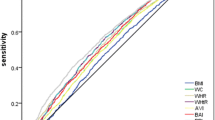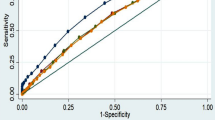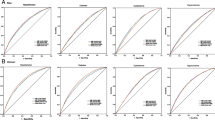Abstract
Introduction
This population-based cross-sectional study aimed to identify the best predictor of the 10-year cardiovascular (CV) high risk among old and new anthropometric indices.
Methods
We investigated 76,915 adults older than 18 years of age living in southwest China. Ten obesity indices were calculated. The 10-year cardiovascular disease (CVD) risk was estimated using the Framingham risk score. Receiver operating characteristic curve analysis was performed to assess the ability of the anthropometric index to predict the 10-year high risk of CVD events.
Results
The waist-to-hip ratio (WHR) had the highest area under the curve (AUC) value (0.711; sensitivity: 62.22%, specificity: 42.73%) in men, while the body fat index (BAI) had the lowest AUC value (0.624, sensitivity: 49.07%, specificity: 54.84%). The waist-to-height ratio (WHtR) and the body roundness index (BRI) showed the highest AUC value (0.751, sensitivity: 39.24%, 39.83%, specificity: 75.68%, 68.59%) in women, while the BAI showed the lowest AUC value (0.671, sensitivity: 53.15%, specificity: 57.14%).
Conclusions
The WHR was the best anthropometric measure for assessing the 10-year high risk of CVD in men, while the WHtR and BRI were the best measures for women. In men, the WHR should be < 0.88, and in women, the WHtR should be < 0.502 or the BRI should be < 3.41.



Similar content being viewed by others
Availability of data and materials
The data that support the findings of this study are available from health management center but restrictions apply to the availability of these data, which were used under license for the current study, and so are not publicly available. Data are however available from the authors upon reasonable request and with permission of health management center.
References
Thelwell M, Chiu CY, Bullas A, Hart J, Wheat J, Choppin S. How shape-based anthropometry can complement traditional anthropometric techniques: a cross-sectional study. Sci Rep. 2020;10(1):12125.
Zhou C, Zhan L, Yuan J, Tong X, Peng Y, Zha Y. Comparison of visceral, general and central obesity indices in the prediction of metabolic syndrome in maintenance hemodialysis patients. Eating and weight disorders: EWD. 2019.
Guerrero-Romero F, Rodriguez-Moran M. Abdominal volume index. An anthropometry-based index for estimation of obesity is strongly related to impaired glucose tolerance and type 2 diabetes mellitus. Arch Med Res. 2003;34(5):428–32.
Valdez R, Seidell JC, Ahn YI, Weiss KM. A new index of abdominal adiposity as an indicator of risk for cardiovascular disease. A cross-population study. Int J Obes Relat Metab Disord. 1993;17(2):77–82.
Milagres LC, Martinho KO, Milagres DC, Franco FS, Ribeiro AQ, de Novaes JF. Waist-to-height ratio and the conicity index are associated to cardiometabolic risk factors in the elderly population. Ciencia & Saude Coletiva. 2019;24(4):1451–61.
Bergman RN, Stefanovski D, Buchanan TA, Sumner AE, Reynolds JC, Sebring NG, et al. A better index of body adiposity. Obesity. 2011;19(5):1083–9.
Krakauer NY, Krakauer JC. A new body shape index predicts mortality hazard independently of body mass index. PLoS ONE. 2012;7(7): e39504.
Thomas DM, Bredlau C, Bosy-Westphal A, Mueller M, Shen W, Gallagher D, et al. Relationships between body roundness with body fat and visceral adipose tissue emerging from a new geometrical model. Obesity (Silver Spring, Md). 2013;21(11):2264–71.
D’Agostino RB, Pencina MJ, Massaro JM, Coady S. Cardiovascular disease risk assessment: insights from Framingham. Glob Heart. 2013;8(1):11–23.
Meseri R, Ucku R, Unal B. Waist:height ratio: a superior index in estimating cardiovascular risks in Turkish adults. Public Health Nutr. 2014;17(10):2246–52.
Ness-Abramof R, Apovian CM. Waist circumference measurement in clinical practice. Nutr Clin Pract. 2008;23(4):397–404.
Hsieh SD, Yoshinaga H. Abdominal fat distribution and coronary heart-disease risk-factors in men-waist height ratio as a simple and useful predictor. Int J Obes. 1995;19(8):585–9.
Nevill AM, Duncan MJ, Lahart IM, Sandercock GR. Scaling waist girth for differences in body size reveals a new improved index associated with cardiometabolic risk. Scand J Med Sci Sports. 2017;27(11):1470–6.
2018 Chinese Guidelines for Prevention and Treatment of Hypertension-a report of the Revision Committee of Chinese Guidelines for Prevention and Treatment of Hypertension. J Geriatr Cardiol. 2019;16(3):182-241.
National guidelines for the prevention and control of diabetes in primary care (2018). Zhonghua nei ke za zhi. 2018;57(12):885-93.
Wilson PWF, D’Agostino RB, Levy D, Belanger AM, Silbershatz H, Kannel WB. Prediction of coronary heart disease using risk factor categories. Circulation. 1998;97(18):1837–47.
Greenhill C. Adipose tissue: sex differences in adipogenesis. Nat Rev Endocrinol. 2016;12(9):497.
Esteghamati A, Mousavizadeh M, Noshad S, Shoar S, Khalilzadeh O, Nakhjavani M. Accuracy of anthropometric parameters in identification of high-risk patients predicted with cardiovascular risk models. Am J Med Sci. 2013;346(1):26–31.
Ramirez-Velez R, Perez-Sousa MA, Izquierdo M, Cano-Gutierrez CA, Gonzalez-Jimenez E, Schmidt-RioValle J, et al. Validation of surrogate anthropometric indices in older adults: what is the best indicator of high cardiometabolic risk factor clustering? Nutrients. 2019;11(8):1701.
Maessen MF, Eijsvogels TM, Verheggen RJ, Hopman MT, Verbeek AL, de Vegt F. Entering a new era of body indices: the feasibility of a body shape index and body roundness index to identify cardiovascular health status. PLoS ONE. 2014;9(9): e107212.
Dhar S, Das PK, Bhattacharjee B, Awal A, Ahsan SA, Shakil SS, et al. Predictive value of waist height ratio, waist hip ratio and body mass index in assessing angiographic severity of coronary artery disease in myocardial infarction patients. Mymensingh Med J MMJ. 2020;29(4):906–13.
Kim SH, Choi H, Won CW, Kim BS. Optimal cutoff points of anthropometric parameters to identify high coronary heart disease risk in Korean adults. J Korean Med Sci. 2016;31(1):61–6.
Ashwell M, Gibson S. A proposal for a primary screening tool: ‘Keep your waist circumference to less than half your height.’ BMC Med. 2014;12(1):207.
Wang K, Pan L, Wang D, Dong F, Yu Y, Wang L, et al. Association between obesity indicators and cardiovascular risk factors among adults in low-income Han Chinese from southwest China. Medicine. 2020;99(30): e20176.
Hu LH, Hu GP, Huang X, Zhou W, You CJ, Li JX, et al. Different adiposity indices and their associations with hypertension among Chinese population from Jiangxi province. Bmc Cardiovasc Disord. 2020. https://doi.org/10.1186/s12872-020-01388-2.
**ao XC, Liu YJ, Sun CL, Gang XK, Cheng J, Tian SY, et al. Evaluation of different obesity indices as predictors of type 2 diabetes mellitus in a Chinese population. J Diabetes. 2015;7(3):386–92.
Hadaegh F, Zabetian A, Sarbakhsh P, Khalili D, James WPT, Azizi F. Appropriate cutoff values of anthropometric variables to predict cardiovascular outcomes: 7.6 years follow-up in an Iranian population. Int J Obes. 2009;33(12):1437–45.
Chen L, Peeters A, Magliano DJ, Shaw JE, Welborn TA, Wolfe R, et al. Anthropometric measures and absolute cardiovascular risk estimates in the Australian Diabetes, Obesity and Lifestyle (AusDiab) Study. Eur J Cardiovasc Prev Rehabil. 2007;14(6):740–5.
Goh LGH, Dhaliwal SS, Welborn TA, Lee AH, Della PR. Anthropometric measurements of general and central obesity and the prediction of cardiovascular disease risk in women: a cross-sectional study. BMJ Open. 2014;4(2):e004138.
Carlsson AC, Riserus U, Engstrom G, Arnlov J, Melander O, Leander K, et al. Novel and established anthropometric measures and the prediction of incident cardiovascular disease: a cohort study. Int J Obes. 2013;37(12):1579–85.
Wang F, Chen Y, Chang Y, Sun G, Sun Y. New anthropometric indices or old ones: which perform better in estimating cardiovascular risks in Chinese adults. BMC Cardiovasc Disord. 2018;18(1):14.
Yalcin G, Ozsoy E, Karabag T. The relationship of body composition indices with the significance, extension and severity of coronary artery disease. Nutr Metab Cardiovasc Dis. 2020;30(12):2279–85.
Liu PJ, Ma F, Lou HP, Zhu YN. Comparison of the ability to identify cardiometabolic risk factors between two new body indices and waist-to-height ratio among Chinese adults with normal BMI and waist circumference. Public Health Nutr. 2017;20(6):984–91.
Wu L, Zhu W, Qiao Q, Huang L, Li Y, Chen L. Novel and traditional anthropometric indices for identifying metabolic syndrome in non-overweight/obese adults. Nutr Metab. 2021;18(1):3.
Wu K, He S, Zheng Y, Chen XP. ABSI is a poor predictor of insulin resistance in Chinese adults and elderly without diabetes. Arch Endocrinol Metab. 2018;62(5):523–9.
Swainson MG, Batterham AM, Tsakirides C, Rutherford ZH, Hind K. Prediction of whole-body fat percentage and visceral adipose tissue mass from five anthropometric variables. PLoS ONE. 2017;12(5):e0177175.
de Almeida RT, Pereira AD, da Fonseca MDM, de Matos SMA, Aquino EML. Association between body adiposity index and coronary risk in the Brazilian Longitudinal Study of Adult Health (ELSA-Brasil). Clin Nutr. 2020;39(5):1423–31.
Dhaliwal SS, Welborn TA, Goh LGH, Howat PA. Obesity as assessed by body adiposity index and multivariable cardiovascular disease risk. PLoS ONE. 2014;9(4):e94560.
Suchanek P, Lesna IK, Mengerova O, Mrazkova J, Lanska V, Stavek P. Which index best correlates with body fat mass: BAI, BMI, waist or WHR? Neuroendocrinol Lett. 2012;33:78–82.
de Lima JG, Nobrega LHC, de Souza ABC. Body adiposity index indicates only total adiposity, not risk. Obesity. 2012;20(6):1140.
Lam BC, Koh GC, Chen C, Wong MT, Fallows SJ. Comparison of Body Mass Index (BMI), Body Adiposity Index (BAI), Waist Circumference (WC), Waist-To-Hip Ratio (WHR) and Waist-To-Height Ratio (WHtR) as predictors of cardiovascular disease risk factors in an adult population in Singapore. PLoS ONE. 2015;10(4): e0122985.
Motamed N, Perumal D, Fhea M, Zamani F, Ashrafi H, Haghjoo M, et al. Conicity Index and waist-to-hip ratio are superior obesity indices in predicting 10-year cardiovascular risk among men and women. Clin Cardiol. 2015;38(9):527–34.
Zhang J, Zhu WH, Qiu LF, Huang LJ, Fang LZ. Sex- and age-specific optimal anthropometric indices as screening tools for metabolic syndrome in Chinese adults. Int J Endocrinol. 2018;2018:1–16.
Hajian-Tilaki K, Heidari B. Comparison of abdominal obesity measures in predicting of 10-year cardiovascular risk in an Iranian adult population using ACC/AHA risk model: a population based cross sectional study. Diabetes Metab Syndr. 2018;12(6):991–7.
Almeida RT, Almeida MM, Araujo TM. Abdominal obesity and cardiovascular risk: performance of anthropometric indexes in women. Arq Bras Cardiol. 2009;92(5):345–50 (62–7, 75–80).
Hernández Rodríguez J, Mendoza Choqueticlla J, Duchi JP. Conicity index and its usefulness for detection of cardiovascular and metabolic risk. Rev Cuba Endocrinol. 2017;2017:1–13.
Pereira PF, Serrano HM, Carvalho GQ, Ribeiro SM, Peluzio Mdo C, Franceschini Sdo C, et al. Measurements of location of body fat distribution: an assessment of colinearity with body mass, adiposity and stature in female adolescents. Revista paulista de pediatria : orgao oficial da Sociedade de Pediatria de Sao Paulo. 2015;33(1):63–71.
Cooke PS, Naaz A. Role of estrogens in adipocyte development and function. Exp Biol Med (Maywood). 2004;229(11):1127–35.
Liu J, Tse LA, Liu ZG, Rangarajan S, Hu B, Yin L, et al. Predictive values of anthropometric measurements or cardiometabolic risk factors and cardiovascular diseases among 44 048 Chinese. J Am Heart Assoc. 2019. https://doi.org/10.1161/JAHA.118.010870.
Haghighatdoost F, Sarrafzadegan N, Mohammadifard N, Asgary S, Boshtam M, Azadbakht L. Assessing body shape index as a risk predictor for cardiovascular diseases and metabolic syndrome among Iranian adults. Nutrition (Burbank, Los Angeles County, Calif). 2014;30(6):636–44.
Corbatón Anchuelo A, Martínez-Larrad MT, Serrano-García I, Fernández Pérez C, Serrano-Ríos M. Body fat anthropometric indexes: Which of those identify better high cardiovascular risk subjects? A comparative study in Spanish population. PLoS ONE. 2019;14(5): e0216877.
Cheung YB. “A Body Shape Index” in middle-age and older Indonesian population: scaling exponents and association with incident hypertension. PLoS ONE. 2014;9(1): e85421.
Chang Y, Guo X, Guo L, Li Z, Li Y, Sun Y. The feasibility of two new anthropometric indices to identify hypertension in rural China: a cross-sectional study. Medicine. 2016;95(44): e5301.
Adegbija O, Hoy WE, Wang Z. Waist circumference values equivalent to body mass index points for predicting absolute cardiovascular disease risks among adults in an Aboriginal community: a prospective cohort study. BMJ Open. 2015;5(11):e009185.
Ashwell M, Gunn P, Gibson S. Waist-to-height ratio is a better screening tool than waist circumference and BMI for adult cardiometabolic risk factors: systematic review and meta-analysis. Obes Rev. 2012;13(3):275–86.
de Koning L, Merchant AT, Pogue J, Anand SS. Waist circumference and waist-to-hip ratio as predictors of cardiovascular events: meta-regression analysis of prospective studies. Eur Heart J. 2007;28(7):850–6.
Acknowledgements
We thank the support from the staff in Health Management Center, West China Hospital, Sichuan University for their generous time and support.
Funding
This work was supported by a grant from the Sichuan province health department (Grant No. Chuanganyan2012-111), the Youth Teacher Research Startup Fund of Sichuan University (2016SCU11016), the horizontal scientific research project of West China hospital (HX20110248) and the Department of Science and Technology of Sichuan Province (Grant Nos. 2017RZ0046, 2018SZ0087).
Author information
Authors and Affiliations
Contributions
QW and LW conceived the experiment(s), FZ; RL; WL; DG conducted the experiment(s), QW and LW analyzed the results. All authors reviewed the manuscript.
Corresponding author
Ethics declarations
Conflict of interest
All authors declare no conflicts of interest
Rights and permissions
About this article
Cite this article
Wu, Q., Zhang, F., Li, R. et al. Identification of the Best Anthropometric Index for Predicting the 10-Year Cardiovascular Disease in Southwest China: A Large Single-Center, Cross-Sectional Study. High Blood Press Cardiovasc Prev 29, 417–428 (2022). https://doi.org/10.1007/s40292-022-00528-3
Received:
Accepted:
Published:
Issue Date:
DOI: https://doi.org/10.1007/s40292-022-00528-3




